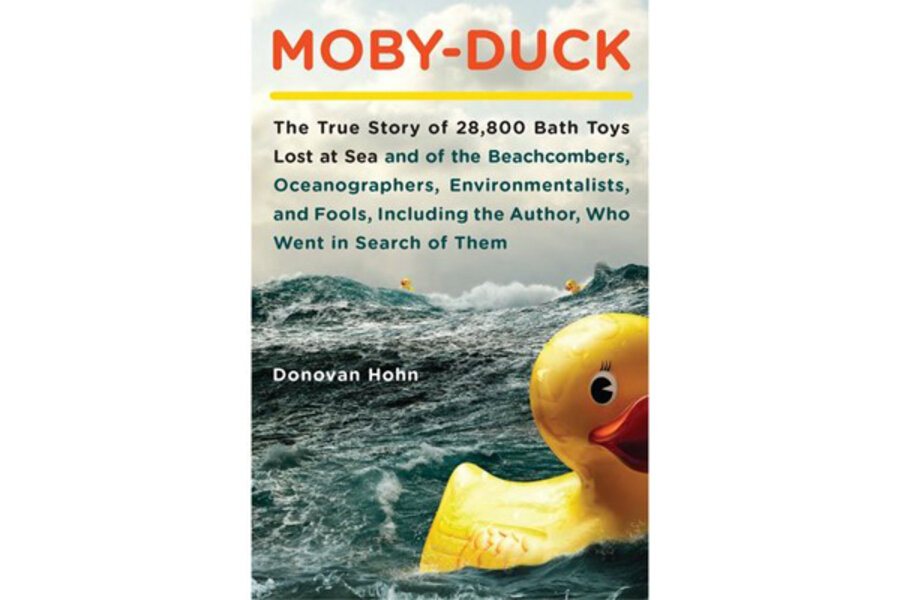Moby-Duck
Donovan Hohn’s narrative about his monomaniacal quest for the elusive yellow duck(s) bobbing somewhere upon the intractable oceans is more than a little Melvillian. The plastic (not rubber) duckies that were cast so carelessly upon the waters are a symbol of our collective, all-consuming sin. Readers of this book will never again smile benignly at cloying little bath toys.
The plot of Moby-Duck (which has an epically long subtitle: “The True Story of 28,800 Bath Toys Lost at Sea and of the Beachcombers, Oceanographers, Environmentalists, and Fools, Including the Author, Who Went In Search of Them”) revolves around the 1992 spill of 28,800 bathtub accessories from a massive container ship in the north Pacific, and the author’s quest more than a decade later to track their journey from China to purportedly pristine places like Hawaii and Alaska, and possibly through Northwest Passage to Maine. Will the author find one of these indestructible icons of domestic bliss on the bounding main, or along some secluded spit of sand, as other beachcombers have? Or will his odyssey end in failure, like that of the doomed Pequod?
A former school teacher, Hohn got the idea for the book from a student’s essay about the spill and toyed with the idea of writing about it from the safety of his home in New York City. His wife was expecting, after all. But he soon was consumed by the watery tale and the search for answers. So off he went, again and again. He would comb and help to clean up beaches in Alaska, which – despite being America’s “Last Frontier” – is awash in startling amounts of debris: fishing gear, bottles, cans and the rest of the relentless plastic flotsam of our ever expanding civilization. The author also trolled for plastic on the high seas, shoved off with scientists studying oceanic currents, and booked a cruise on a container ship like the one that disgorged all those duckies (beavers, frogs, and turtles spilled, too, but these, clearly, are less charismatic commercial litter).
Cleaning up a remote beach where grizzly bears forage is hardly the answer to plastic pollution, it turns out. The shoreline will be well littered again in no time. And where does that leave the oceans, where our floating industrial waste stream often is aggregated by the currents into places with names like the Great Pacific Garbage Patch? The oceans were once thought to be too vast for us to properly befoul – even Rachel Carson thought as much for a time. The Great Pacific Garbage Patch is roughly the size of Texas and growing, and plastic has become as common as plankton in many places. Birds and fish mistake the smaller portions for food.
Hohn, who is now the features editor at GQ, writes with precision and passion about what he sees and learns on his various travels and about his discussions with scientists, mariners, do-gooders, and beachcombers. His writing is lively and literate, filled with vivid descriptions, telling context, and lightly seasoned with quotes from Melville and others. He knows a symbol when one bobs into his ken, and what to do with it: “Here, then, is one of the meanings of the duck. It represents this vision of childhood – the hygienic childhood, the safe childhood, the brightly colored childhood in which everything, even bathtub articles, have been designed to please the childish mind, much as the golden fruit in that most famous origin myth of paradise ‘was pleasant to the eyes’ of childish Eve.”
The author also knows a clever con when he sees one. He concludes that “Keep America Beautiful” approaches, which are largely spawned and bankrolled by the very corporations that are producing all the plastic detritus, are not the answer. There is no way to keep much of anything beautiful when barely five percent of all plastic we use is recycled. The whole point of plastic things is that they are made to be thrown away; that’s what makes them so darn consumer-friendly and profitable. What companies are doing with their “Let’s Not Litter” PR is to “greenwash” their own sizeable and systemic culpability, according to Hohn.
So what is the answer to oceans beset by a rising tide of indestructible trash? One is people like boat captain Charlie Moore, a self-made scientist and activist, who works to raise public awareness of the problem and lobbies for more enlightened regulations and corporate practices. Others Hohn encounters are volunteering their time and money to clean up our collective mess.
But the author wonders if such solutions, nibbling around the edges, are enough: “I’d like to share Moore’s faith in the arc of progress.... but I had a hard time imagining the bright future he saw, in which we Americans would trade conspicuous consumption for cradle-to-cradle manufacturing practices, disposable plastics for zero-waste policies and closed ecological loops. I had a hard time because such a future seemed to me inimical to the American gospel of perpetual economic growth.”
David Holahan is a freelance writer in East Haddam, Conn.






